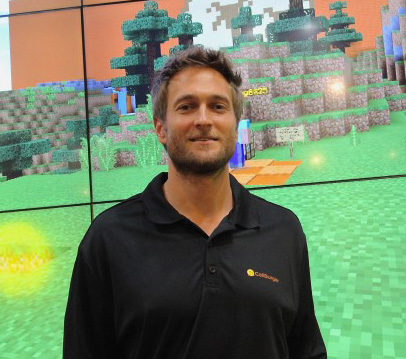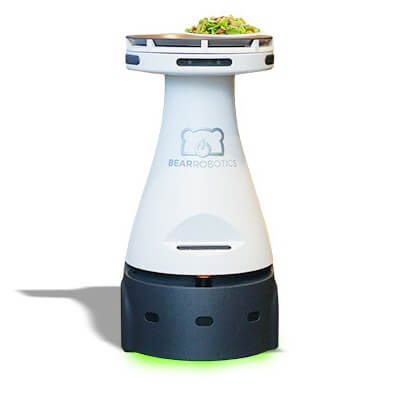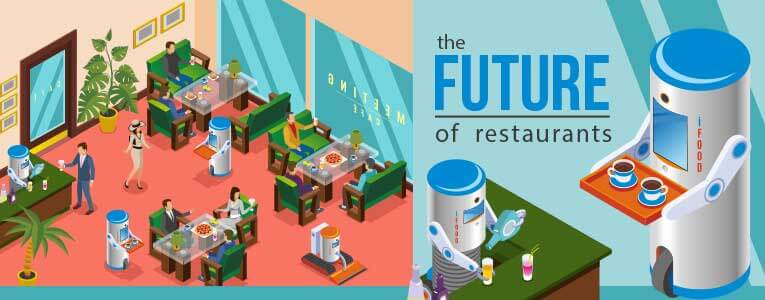Every year, we have the opportunity to exhibit at the National Restaurant Association Show in Chicago, IL. In addition to showing off our newest furniture collections and meeting with new and former customers, we also try to bring back some helpful information for our readers that couldn’t attend. The NRA show is the premier event in the hospitality industry with the potential to set the tone and trends for the entire industry.
This year, we went to a session called “The Future of Restaurants”. It was a panel presentation headlined by popular futurist, strategist, and author, Daniel Burrus, whose book “The Anticipatory Organization”, we haven’t put down since getting a free copy at the door. Burrus was followed by 3 great presentations by Sarah Lockyer, Senior Vice President or Winsight Media; John Miller, CEO of Cali Group; and John Ha, Founder and CEO of Bear Robotics. Each presented their unique take on how the restaurant industry is being disrupted by new technologies, and what the future holds. Below is a short summary of their talking points.

Daniel Burrus: Hard Trends vs. Soft Trends
According to Burrus, the trick to finding opportunities and succeeding in business is identifying trends and distinguishing the hard trends from the soft trends. Hard trends are trends that WILL happen, at least with a high degree (90%+) of certainty. They are based on facts, and driven by things like demographics, technology, and government regulation. An example of a regulatory hard trend would be the state by state legalization of marijuana leading to opportunities for commercialization. Soft trends, on the other hand are trends that MIGHT happen. They are educated guesses, but are sensitive to disruption, and can change at any moment. In fact, they present an opportunity for you to change them, and influence the future. One example of a soft trend would be which companies will emerge as the de-facto mainstream consumer marijuana brands; we can make an educated guess based on size, market share, products, etc., but there are no guarantees and a disruptive brand could take over the industry at any time.
Burris argued that the safe bet is to put your money on the hard trends. So, the relevant question here is “What are the hard trends happening in the restaurant industry that will shape the future, and what opportunities do they present”?
The answer is the convergence of many factors: rising restaurant input costs and wage pressures, the increasing number of millennials and Gen Xers entering the marketplace, the widespread use of mobile devices, the growth and development of AI and facial recognition technologies, and advancements in the field of robotics and automation.
Sarah Lockyer: A Good Place to Start
As the Senior Vice President for Winsight Media and Restaurant Business, Sarah Lockyer likely has her finger on the pulse of everything that’s happening in the restaurant industry, and the data to back it up. So, when she started talking, we listened. She gave an overview of the trends that are starting to gain traction in the industry now, and will continue to grow over the next 5-10 years. The great thing about her presentation was that many of these trends are, or will be soon, accessible to all restaurants, not just chains and corporates with multi-million dollar budgets.
Ordering Kiosks – If you go to enough fast food joints, you’re bound to run across an ordering kiosk soon. McDonalds is reportedly going to add 1000 kiosks to their stores per quarter for the next 8 or 9 quarters, so it won’t be long until they are pervasive throughout the country. They are already widespread in Canada, Europe, Australia, and Asia. Ordering kiosks take advantage of many hard trends: a booming, tech savvy younger generation with disposable income; rising wage pressures that are pushing operators towards automation solutions; and cheaper touchscreen technologies. So far, 13% of people in the US have ordered from a kiosk, including 20% of those from 18 to 44. That number will increase as kiosks pop up in more locations.
Tabletop Tech – How do you get your guests to turn over their tables quicker, spend more, volunteer their data, and sign up for your loyalty program? The answer just might be a tabletop technology solution like those from Ziosk and eTouchMenu. According to a study from Cornell University, customers spent $3.61 more and turned over 31% quicker at one full-service chain restaurant when tablets were present on the table. Researchers noted that the biggest gains came when guests could order refills and pay the check on the tablet without having to wait for the server to get to them. With stats like that, tabletop technology could be the quiet breakout trend for years to come, and one that is becoming affordable enough for even single unit operators to consider.
Takeout and Delivery – As we’ve written about before, takeout and delivery is becoming an even bigger deal for restaurants of all kinds. No longer only the domain of pizza and Chinese food, full service restaurants are now getting in on the action with partnerships with Grubhub, Uber Eats, Door Dash, and even Amazon. Millennials and urbanites are driving this trend, with 49% of 18-34 year olds saying that they order food more often than they did 3 years ago. If you’re in a metropolitan area and don’t offer delivery, chances are you’re missing an opportunity to increase your sales and get your brand out there.
Virtual Restaurants – Expanding on the concept of takeout and delivery are virtual restaurants, businesses that are set up for the sole purpose of serving delivery only meals. Often started in shared “warehouse” type spaces, virtual restaurants save all the costs of starting a true brick and mortar establishment, reducing the risk of starting a new concept. They rely on delivery companies like those mentioned above to handle the marketing and delivery of their food, and the only staff required are the cooks. If you are a Rockstar chef without the funding to open a full-scale restaurant, then a virtual restaurant might be perfect for you. A virtual restaurant could also be the perfect expansion plan for a restaurant with a cult-like following that doesn’t want to invest in another traditional storefront.
Dynamic pricing – Uber does it. So do airlines, hotels, and car rental places. So, why not your restaurant? The “it” that we’re talking about is called dynamic pricing, and it means nothing more than changing your prices based on demand; a throwback to classic economic theory. When demand is high, say on a Saturday night when your wait time is 45 minutes, you charge more. When demand is low, like Monday afternoon, then you offer a discount to draw in price sensitive customers. The trick is to maximize your profits by striking a balance between the price customers pay and staying at or near maximum capacity. In reality, dynamic pricing isn’t as easy as it sounds. Lowering prices via discounts and coupons is great in off-peak times, and there are several apps like TasteBud that make it easy to manage, but raising prices during busy times is another matter. Only time, and a few intrepid restaurant owners who are willing to take on the experiment, will tell if the restaurant industry can sustain a truly dynamic pricing model.

John Miller: Data with a Side of Burgers
For John Miller, Co-Founder and Chairman of Cali Group, the restaurant of the future will be a data centric, automated organization, and he wants to own that customer data, just like Google owns online data. Miller who has said that his chain Cali Burger was a “Technology company that happens to sell cheeseburgers” is building his business around a suite of technologies that are designed to collect that data and use it to maximize sales.
Facial Recognition for Payment – PopIQ is Cali Group’s company that develops machine vision technologies for the restaurant sector. They are currently testing an ordering kiosk that lets you pay with your face. You walk up to the kiosk, it recognizes your face, shows you your previous orders and favorite items, and then lets you place your order and pay using a credit card on file. The machine will reportedly even check into your Yelp reviews to see if you’ve had any problems with the restaurant that require special attention from a manager. This will give PopIQ a tremendous amount of customer data which it can use to create personalized deals that drive traffic. However, whether or not consumers will view this as an invasion of privacy issue is yet to be determined.
POPIQ from WINTERSTONE on Vimeo.
Social Gaming – Another of Cali Group’s portfolio companies called Funwall is investing in social gaming. While social and mobile games have been around for some time now, Funwall combines the games with incentives like in-venue only prizes that increase foot traffic to restaurants and build loyalty. Honing in on the trend of a growing millennial customer base, Funwall provides restaurants an opportunity to create experiences, and separate themselves from the competition.
Smart Delivery & Shared Spaces – Basically a WeWork for virtual restaurant startups, Kitchen United is a company that provides shared kitchen spaces for delivery only restaurants. As Sarah Lockyer talked about earlier in the conference, shared spaces enable restaurant concepts to save money while still having access to state of the art equipment. Kitchen United offers even more value by providing business intelligence, and resources that wouldn’t be available to a restaurant going it alone in their own space. Shared spaces are also a great place to network and share ideas with fellow chefs and restaurant owners.
Robotic Automation – As labor and regulatory costs (think OSHA) continue to rise, companies are looking to cash in on the growing trend of automation in the workplace. Cali Group is no different, and their portfolio company Miso Robotics is developing an automated burger flipping robot aptly named “Flippy”. Flippy uses machine vision and artificial intelligence to “see” burgers on the grill, flip them, tell when they are perfectly cooked, and put them on the bun. Right now, Flippy still requires a companion human to load the burgers onto the grill, but we can see that step being eliminated in the future. Right now, Flippy can cook up to 300 burgers per day, more than a human counterpart, which means that it is more efficient, cheaper, and more reliable than hiring human cooks. As robots like Flippy become more prevalent in the industry, low paying jobs will get eliminated and will open the way for higher paying jobs like maintenance technicians, engineers, and support personnel.

John Ha: Rise of the Machines
If there’s anybody who should know about the intersection between the hospitality industry and technology, it’s John Ha. After he left his job at Google, he purchased a Korean restaurant in California. As he related in his talk, he found that the work was harder than he expected, and he found that nobody in the restaurant was happy with the service: employees, customers, or himself. So, he started to think about ways to improve the customer experience by making his employees more than just order takers and food delivery people.

His answer was Penny, a robot that does the grunt work of delivering meals tableside, freeing up employees to engage with customers and create a great experience. Penny, currently in the testing phase at Ha’s own restaurant, uses artificial intelligence to navigate “her” way through the dining room, avoiding customers and obstacles, and delivering the food to each table in his restaurant. Ha’s company Bear Robotics is already taking pre-orders for the robot.
Ha says that since he started testing Penny, his restaurant has seen an 8% sales bump, and an 18% increase in tips for his servers. Whether that is due to the novelty factor of seeing a robot deliver your meals or an actual increase in perceived value of service is still up in the air, although Ha says it is the latter. One thing is for sure, the rise of the robots is quickly turning into a hard trend that will need to be anticipated and adapted to if you want your restaurant to continue to compete in the future.
We really enjoyed attending this session and bringing the valuable information back to our readers. Innovation is a moving train that can’t be stopped, so it’s important to stay current and adapt to the trends that will change the industry because, as Daniel Burrus said, “If you don’t seize the opportunity, you can be sure that somebody else will”.







